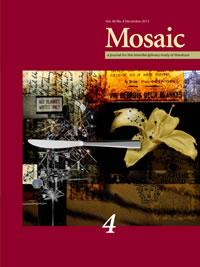Issue 46.4
Overview

General Issue
Published: December 2013
View the issue introduction or see the issue summary and contents below.
10 essays, totalling 192 pages
$21.95 CAD
The issue includes ten essays that engage the work of J.M. Coetzee, Coline Serreau, Wallace Thurman, Theresa Hak Kyung Cha, Margaret Atwood, and Sylvia Plath, among others. From the biopolitics of haiku to the rhetoric of the network, the issue is marked by heterogeneity.
Feeling, Affect, Exposure: Ethical (In)Capacity, the Sympathetic Imagination, and J. M. Coetzee’s DisgracePhilip Dickinson This essay considers the role of feeling and affect in theories of the sympathetic imagination through readings of Martha Nussbaum, Geoffrey Hartman, and J.M. Coetzee’s Disgrace. I explore how the sympathetic imagination is irreducibly contaminated by unstable affective states that threaten its viability as a humanist ethic. | |
Social Commentary in Coline Serreau’s Saint-Jacques. . . La MecqueLisa F. Signori In Saint-Jacques. . . La Mecque, Coline Serreau uses medieval pilgrimage to shed new light on social issues in contemporary French society. This essay examines the motivations and experiences of nine modern pilgrims who walk to Compostela and learn to overcome barriers of race, gender, and intolerance. | |
Rhetoric of the Network: Toward a New MetaphorChristopher D. Kilgore The “network” has become a dominant metaphor in contemporary thought. By analyzing its history, this essay argues that this metaphor has evolved through re-projection, and that several literary texts also suggest that an imminent paradigm shift may address longstanding interdisciplinary concerns with the network-concept’s adequacy. | |
Wallace Thurman’s The Blacker the Berry and the Question of the Emancipatory CityCatherine Rottenberg Focusing on the representation of Harlem, I examine how Wallace Thurman’s 1929 The Blacker the Berry explicitly challenges the notion of “the emancipatory city” while emphasizing the spatial aspect of subject formation. Thurman underscores both the city’s liberating potential and its simultaneous tendency to reinforce dominant normative schemes. | |
The Anti-Hero in Modernist Fiction: From Irony to Cultural RenewalShadi Neimneh This essay considers anti-heroism as a response to modern man’s uncertainties about traditional values and as a feature of modernity’s zeitgeist. Modern anti-heroism captures the sensibility associated with modernism, with its attempts at cultural renewal, and it ranges between the low mimetic and the ironic mode. | |
Stalking the Gaps: The Biopoetics of HaikuIan Marshall Examined through the lens of evolutionary literary criticism, or “biopoetics,” haiku exemplifies several evocritical ideas about the adaptive functions of art. It is an exercise in “making special,” or marking significant rituals, a means of promoting social bonding, and a kind of cognitive play that exercises our abilities in symbolic thought. | |
The Limits of the Story: Reading the Castaway Narrative in A Strange Manuscript Found in a Copper Cylinder and Life of PiDaniela Janes Both Life of Pi and A Strange Manuscript Found in a Copper Cylinder juxtapose the narrative of a castaway’s experiences with the later telling of the tale. Exploring the limits of “story,” they present fantastic narratives that trespass upon credulity and that require—but do not always receive—a leap of narrative faith. | |
Embodying the In-Between: Theresa Hak Kyung Cha’s DicteeHyo K. Kim Aligning Dictee with its historical author Theresa Hak Kyung Cha has been at once theoretically vexing and pivotal to the formation of Asian American studies. This essay reprises that topic by exploring an under-theorized dimension of Dictee’s formal experimentation, which involves how affect embodies the relation between self and world. | |
The Chinese Stereotypical Signification in Ah SinHsin-yun Ou This essay examines the racial ideology exemplified in Ah Sin as it played out in multiple venues, particularly the Gilded Age economy and the conventions of yellowface performance. Highlighting the ambivalence of the Chinese title character, the play marks an emphatic step toward disrupting what Homi Bhabha defines as the “fixity” of racialized stereotypes. | |
Medusa as Female Eye or Icon in Atwood, Murdoch, Carter, and PlathGillian M.E. Alban This essay explores the mythic Medusa archetype, used as a symbol of female psychic power in the writings of Angela Carter, Margaret Atwood, Iris Murdoch, and Sylvia Plath. |